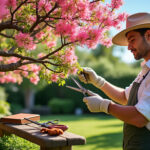The delicate balance of timing and technique is crucial for maintaining a flamingo tree’s vibrant growth. Pruning is not merely an act of cutting but a strategic approach to enhance health, correct form, and stimulate new growth. Understanding the best seasons, recognizing the subtle signs indicating when to act, and employing effective pruning methods are essential components of nurturing these unique plants. This presentation covers the key aspects of when to prune a flamingo tree, the techniques to employ, and the post-pruning care necessary for optimal results.
Understanding the Ideal Pruning Seasons for Flamingo Trees
Identifying the optimal times for pruning a flamingo tree can significantly influence its health and growth trajectory. Generally, the best seasons for this process align with the tree’s growth cycle and dormancy. Recognizing these periods allows for effective rejuvenation and maintenance.
Spring Pruning: Encouraging New Growth
Spring emerges as the prime period for rejuvenation pruning. As temperatures rise and the daylight increases, the flamingo tree awakens from dormancy, initiating new growth. Pruning during this season stimulates fresh foliage and vibrant blooms, as the plant is naturally gearing up for active development. During this time, pruning should focus on:
- Removing dead or damaged limbs 🌿
- Shaping and sculpting the tree for aesthetic balance ✂️
- Encouraging airflow by thinning out crowded areas 💨
This proactive approach not only enhances visual appeal but also fortifies the tree against potential diseases and pests that thrive in shaded, congested environments.
Fall Pruning: Preparing for Dormancy
Fall, conversely, serves as an ideal time for maintenance pruning. As the flamingo tree prepares to enter its dormant phase, adjustments made during this season help transition the plant into its restful period smoothly. Key considerations during fall pruning include:
- Trimming away spent flowers to conserve energy for next spring’s blooms 🌺
- Removing any diseased or damaged branches to prevent overwintering pests ❌
- Lightly shaping the tree to promote structure and form 🍂
Engaging in these practices ensures that the flamingo tree retains its vigor through winter and emerges vibrantly when spring arrives.
Timing Considerations Based on Growth Cycle
Timing is inherently tied to the flamingo tree’s growth cycle. Understanding this rhythm allows for more strategic and effective pruning. Active growth phases, generally observed in late spring and through summer, should involve minimal pruning interventions, focusing instead on maintenance. During these months, any intensive pruning can be detrimental by stimulating stress, which the plant may not have the energy to cope with while actively developing new growth.
| Season | Pruning Focus | Goals |
|---|---|---|
| Spring | Rejuvenation Pruning | Encourage new growth and enhance structure |
| Fall | Maintenance Pruning | Prepare for dormancy and prevent disease |
Recognizing the distinct needs during these phases sets the foundation for successful pruning, ultimately leading to a healthier and more vibrant flamingo tree.
Recognizing Signs That Indicate It’s Time to Prune
Before taking any action, keen observation of the flamingo tree is essential. Several visible signs indicate when it’s time to prune, ensuring that interventions occur most effectively.
Key Indicators for Pruning
Monitoring the health of the flamingo tree involves looking for specific indications that suggest a pruning session is necessary. These signs can include:
- Yellowing or Browning Leaves: This can signal underlying health issues or stress caused by environmental factors or age 🍂.
- Overgrown Appearance: Crowded branches can lead to limited airflow, fostering an environment where pests or diseases may thrive 🌳.
- Spent Flowers: Flowers that have completed their blooming cycle should be removed to encourage fresh growth and maintain the plant’s aesthetic appeal 🌼.
By recognizing these signals early, proactive measures can be taken, preventing further complications and promoting a healthier plant overall.
Understanding the Growth Rhythm
Each flamingo tree develops according to its growth rhythm. During the active growth phase in spring and summer, interventions should be cautious to avoid stressing the plant. Instead, focus on monitoring for the previously mentioned signs, and act accordingly when they appear.
Effective Techniques for Pruning Flamingo Trees
Mastering proper pruning techniques is critical for achieving desired results. Employing effective practices ensures that the flamingo tree remains healthy and visually appealing post-pruning.
Identifying the Right Stems and Leaves to Prune
Start by targeting dead or damaged leaves before moving on to the branches. Removing these can greatly improve the health of the plant and create space for new growth. Furthermore, the following techniques should be applied:
- Cutting Technique: When making cuts, aim for a 45-degree angle to prevent water accumulation, which can lead to rot 🌧️.
- Shaping Techniques: Trim branches to attain the desired size and shape, promoting proper aesthetics while also ensuring ample light reaches all areas of the tree 💡.
Tools for Pruning
Utilizing the right tools can drastically affect the results of the pruning process. Common tools that every gardener should consider include:
- Saw: Useful for thicker branches that require more power to cut through 🛠️.
- Pruning Shears: Ideal for delicate or thin branches, ensuring clean cuts for better healing 👌.
- Loppers: Perfect for reaching high or thick branches while providing enough leverage for significant cutting force ⚒️.
Having these tools at hand ensures that the pruning process is efficient and effective, leading to better outcomes for the flamingo tree.
How to Avoid Damaging the Plant During Pruning
Pruning can be a precarious task; thus, precautions must be taken to avoid causing undue damage to the tree. Some essential tips include:
- Avoid Cutting Too Close: Always leave a small margin to help the plant heal properly 🌱.
- Using Clean Tools: Disinfect tools before use to prevent infections and promote healing, ensuring the plant thrives post-pruning 🧼.
- Identify Nodes: Whenever possible, prune directly above nodes to encourage new growth and rejuvenation 🌿.
| Technique | Description | Tip |
|---|---|---|
| Angle of Cuts | Maintain a 45-degree angle | Reduces water accumulation |
| Targeting Dead Growth | Remove dead or damaged limbs | Promotes overall tree health |
With effective techniques and careful considerations, pruning your flamingo tree can lead to a healthier, more vibrant plant, setting up a foundation for rejuvenation and beauty.
When to harvest broad beans for the best yield
Understanding the Importance of Deadheading
Deadheading is a vital aspect of maintaining the health of the flamingo tree, directly influencing its overall blooming success. This practice involves removing spent flowers to provide the tree with energy reserves for future growth.
Benefits of Deadheading
Incorporating deadheading into the regular care routine for a flamingo tree brings numerous benefits. Some of the most notable advantages include:
- Extended Blooming Period: Regularly removing spent flowers encourages the production of new blooms, extending the flowering season 🌸.
- Energy Conservation: By preventing the plant from directing resources towards seed production, deadheading allows it to conserve energy for more robust flower production in subsequent cycles 🍃.
- Improved Aesthetic Appeal: Removing wilted or browning flowers keeps the tree looking fresh and inviting 🌼.
Step-by-Step Instructions for Deadheading
Successfully deadheading involves a straightforward approach that ensures minimal stress to the plant. Following these steps can guide the process:
- Identify Spent Flowers: Look for wilting or browning blooms indicating the need for removal 🌸.
- Use Clean Pruning Shears: Ensure your tools are disinfected to prevent infections 🧽.
- Trim the Flower Stem: Carefully cut just below the spent bloom while avoiding damage to surrounding leaves 🔪.
Recognizing When to Deadhead
Observation is crucial when deadheading. Key indicators for when flowers are ready to be deadheaded include:
- Fading Color: As flowers lose their vibrancy, it signals the optimal time for removal ⚠️.
- Wilting Petals: Flowers displaying signs of wilting are also prime candidates for deadheading 🌼.
| Indicator | Action | Outcome |
|---|---|---|
| Color Fading | Deadhead the flower | Encourages fresh blooms |
| Wilting Petals | Remove spent flowers | Boosts new growth |
Incorporating regular deadheading into the maintenance routine of a flamingo tree not only enhances its beauty but also fosters a more robust growth cycle.
Navigating Common Pruning Challenges
Pruning can present various challenges that may hinder the growth and health of the flamingo tree. A keen awareness of these challenges, along with effective strategies to mitigate them, is essential for success.
Addressing Over-Pruning and Its Effects
One of the most significant issues faced during pruning is over-pruning. This can lead to distress signs such as stunted growth, leaf drop, and overall plant stress. If excessive cuts are made, the plant may struggle to recover, making it vital to:
- Monitor Growth Patterns: Ensure that observed growth is healthy and not stunted 🔍.
- Give Time to Recover: Let the plant rest after a pruning session to allow for adequate recovery and healing 💚.
Handling Pests or Diseases During Pruning
While engaging in pruning activities, it is essential to inspect the flamingo tree for any pests or diseases, as these can affect overall health. Some actionable strategies include:
- Inspection: Regularly check both leaves and stems for signs of infestation 👀.
- Treatment Options: Employing gentle treatment options such as insecticidal soap or neem oil can effectively manage any pest issues while preserving plant health.
Recovering from Improper Pruning
If the flamingo tree shows signs of damage due to improper pruning, taking corrective actions is vital. Some recovery tips include:
- Assess the Plant’s Condition: Determine areas that require immediate attention or care 🩹.
- Adjust Care Routines: Modifying watering frequencies and light conditions can support recovery and facilitate better healing 🌞.
| Challenge | Description | Solution |
|---|---|---|
| Over-Pruning | Causes stunted growth | Monitor growth and reduce frequency of cuts |
| Pests During Pruning | May compromise plant health | Inspect and apply treatments |
Through awareness and effective responses to common challenges, caregivers can ensure that their flamingo trees flourish, embodying health and vibrancy.
Post-Pruning Care for Flamingo Trees
The journey doesn’t end with pruning. Providing adequate care post-pruning plays a significant role in ensuring that the flamingo tree remains healthy and vibrant.
Care Tips After Pruning to Promote Regrowth
After pruning, nurturing the flamingo tree becomes essential for optimal regrowth. Several key strategies include:
- Consistent Moisture: Maintain appropriate soil moisture levels, being cautious to avoid overwatering which can lead to root rot 🌊.
- Indirect Light Exposure: Ensure the tree receives adequate light without facing intense sunlight, which may cause stress ☀️.
Monitoring Plant Health Post-Pruning
Regular monitoring assists in ensuring that the tree recovers effectively following pruning. Look out for:
- Signs of Stress: Watch for yellowing leaves or wilting, indicating the need for adjustments in care 🌿.
- Adjustment Readiness: Be prepared to modify watering and light conditions based on observed tree health 📊.
Fertilization and Watering Considerations After Pruning
A proper fertilization schedule post-pruning can stimulate and speed up the recovery process. Recommendations include:
- Balanced Fertilizer: Apply every 4-6 weeks to provide necessary nutrients for growth 🍃.
- Water Regulation: Closely monitor soil moisture levels, adjusting watering frequency as needed to ensure optimal hydration without waterlogging 🚰.
| Care Aspect | Focus | Recommendation |
|---|---|---|
| Moisture | Soil Consistency | Avoid overwatering |
| Light | Exposure Type | Indirect light is preferable |
Through proper post-pruning care, the flamingo tree will not only recover but also thrive, showcasing its beauty for years to come.
FAQ
When is the best time to prune a flamingo tree?
The best time to prune a flamingo tree is typically in late winter or early spring before new growth begins.
What are signs that a flamingo tree needs to be pruned?
Signs include yellowing leaves, an overgrown appearance, and spent flowers requiring removal for fresh blooms.
How can over-pruning impact a flamingo tree?
Over-pruning can result in stunted growth, leaf drop, and an increase in plant stress.
What tools are best for pruning a flamingo tree?
Essential tools include sharp pruning shears, loppers for thick branches, and a pruning saw for larger limbs.
How to care for a flamingo tree after pruning?
Post-pruning care should include consistent moisture, monitoring plant health, and a balanced fertilization schedule.
















